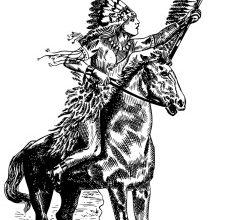
An Angel in Disguise is a short story by T.S Arthur which beautifully demonstrates the power of love in a situation of hopelessness. Written in the voice of a third person omniscient narrator, the story makes a strong case for compassion towards the downtrodden and tries to draw a clear connection between love and happiness.
Got No Time? Check out this Quick Revision by Litbug. Click on the link below
https://litbug.com/2018/12/13/summary-and-analysis-of-an-angel-in-disguise-by-t-s-arthur/
An Angel in Disguise | Summary
An Angel in Disguise by T. S Arthur opens with a very graphic representation of misery and helplessness. A woman has died in poverty (presumably due to disease and alcohol abuse), surrounded by her wretched children. The news of her death quickly spreads in the village and the neighbors hastily gather around her dead body, bringing along some food and clothes for her orphaned children. The narrator shows how pity moves the villagers to action and goes on to state that “Death touches the spring of our common humanity.”
Three children are orphaned by the death of their mother: John, Kate and Maggie. John, the eldest, is a boy of twelve. Kate, about ten to eleven, is an active and a bright girl. Maggie, the youngest, is hopelessly diseased. She had been handicapped after having fallen from a window two years earlier, injuring her spine. The villagers discuss what should be done about the children and they all agree that the little ones must not be left to starve. Finally, farmer Jones adopts John and Kate is adopted by Mrs. Ellis. Though it may seem like a commendable act on their part, their decision to “adopt” the children, their decision is actually based on self interest as shall be seen later in the analysis of the story.
Nobody comes forward to adopt poor Maggie and some suggest taking her to the Poor House. Finally, it is the wheelwright Joe Thompson who, unable to resist Maggie’s pleas, lifts her up in his arms and heads home. He’s sure that his wife, a childless woman, will resist his choice of adoption but he decides to take Maggie anyway. On reaching home, he and his wife have a heated argument over Maggie’s adoption. The wife strongly resists the adoption of an invalid child. However, Thompson passionately defends the child and speaks on her behalf with such force that Mrs. Thompson finally agrees to keep her for the night. Joe gives the example of how Jesus loved little children and makes a fervent appeal to his wife:
” Look at her kindly Jane; speak to her kindly. Think of her dead mother, and the loneliness, the pain, the sorrow that must be all her coming life.”
He leaves Maggi to Mrs. Jones’ care before going to work. Upon his return, he doesn’t mention Maggie but instead asks for the supper. He goes to meet the child and is struck by her tender voice and the gratefulness of her tone. During supper, Mrs Thompson brings up the topic of Maggie and asks him what he is going to do with the child. Joe replies very tactfully, pretending to be surprised: ” I thought you understood me that she was to go to the Poor House.” Mrs. Thompson looks strangely at her husband and drops her eyes.
She then prepares some meal and takes it to Maggie who eats it with great pleasure :
“Is it good?” asked Mrs Thompson, seeing with what keen relish the food was taken. The child paused with the cup in her hands, and answered with a look of gratitude that awoke to life old human feelings which had been slumbering in her heart for half a score of years.”
Mrs Jones is clearly touched and we will see that her attitude towards the child is changed forever. The next morning at breakfast time, in response to Joe’s statement that he must see the Guardians of The Poor House concerning Maggie, Mrs Thompson remarks that they will keep Maggie for a day or two longer. However, Joe never visits the Guardians of the Poor on Maggie’s account, for in less than a week Mrs Joe Thompson has become so attached to Maggie that she would rather herself go to the Alms house than send Maggie there.
The story ends on a happy note explaining how Maggie acted as an object of love to bring happiness in the house of Joe Thompson, especially in the life of his wife which had so far been an unhappy one, for being without a child, she had nothing to love and care for out of herself.
Maggie thus becomes a ‘precious burden’ to the Thompson family- an angel who had come to his house disguised as a sick and miserable child, and filled its dreary chambers with the sunshine of love.
An Angel in Disguise | Historical Context
This story was much more popular when it was written because it reflected the problems the 19th century American society had been dealing with: alcohol abuse and child labor.
A sound critical appreciation of An Angel in Disguise becomes impossible if the question of alcohol abuse and its historical context isn’t taken into consideration. As mentioned in About the author section, T.S Arthur was a great proponent of the “Temperance Movement“, a 19th Century puritanical movement against alcoholism which sought to curb the ‘evils’ of liquor. The extent to which Arthur was obsessed with the idea can be gauged by the fact that he built his entire literary career by writing against alcoholism. This may not seem a big deal today but the 19th century American context will tell us that the problems posed by alcohol abuse had real consequences. This is also is also reflected in various books about the period like The Alcoholic Republic : An American Tradition by W.J Rorabaugh and The Liquor Problem in All Ages by Daniel Dorchester. Alcohol in one form or another found itself included in breakfast, lunch and supper of 19th century Americans. The increasing immigrant population and cheap means of production led to the increase in alcohol consumption and the abuse of the drink led to various social problems like violence and the neglect of children by alcoholic parents. By 1819, alcohol abuse was seen as a disease which needed cure and was even given a name: dipsomania .
The abovementioned paragraph provides a historical context that T. S Arthur is writing the story. Moving further with the analysis of An Angel in Disguise.
An Angel in Disguise | Analysis
An Angel in Disguise is a popular story by T.S Arthur which deals with themes of compassion, responsibility, the power of love and the need for temperance.
It shows how the power of love can not only transform the life of the less fortunate (like Maggie in this case) but also fill up the emptiness in the lives of those who desperately need love without even realizing that they do (like Mrs. Thompson). An Ange in Disguise opens with the children being orphaned because of the death of their alcoholic mother, whose deaths, is to a large extent, caused by intemperance. The story opens with the lines:
” Idleness, vice, and intemperance had done their miserable work and the dead mother lay cold and still amid her wretched children. She had fallen upon the threshold of her own door in a drunken fit, and died in the presence of her frightened little ones.”
An Angel in Disguise is therefore a social commentary which not only shows the consequences of a social ‘problem’ but also hints at how the results of the problem can be mitigated: by the love and kindness of people who are willing to take responsibility of the innocent lives that have been destroyed by the alcohol problem
Strong Biblical influence which marked the T.S Arthur’s formative years is also visible in this story. Joe gives the example of Jesus and his attitude towards children while making a case for Maggie’s adoption
“I read in the Bible sometimes, and find much said about little children. How the Savior rebuked the disciples who would not receive them; how he took them up in his arms, and blessed them; and how he said that ‘whosoever gave them even a cup of cold water should not go unrewarded.’,
Angel in Disguise also acknowledges the fact that most of the actions undertaken by people are based on self interest and that there is a certain degree of hypocrisy lodged between people’s actions and their intentions. The hypocrisy of the society is revealed the day after the mother’s death when John and Kate are quickly adopted by farmer Jones and Mrs. Miller respectively for the cheap labor they bring along with them and by the virtue of which they can be ‘of use’. Maggie however is abandoned by all. Their hypocrisy is revealed in the chasm between their explanation for adopting the kids and their intention behind it.
Consider Mrs. Ellis who says that she “must act from a sense of duty” and that it would be “charitable” on her part to choose Kate when in fact, she had actually been “looking out for a bound girl”. The reason behind the adoption of the children by the farmer and Mrs. Ellis is of great significance as it hints at another major social issue of the time: child labor. By their own admission, we see that farmer Joe wants young John “now that his mother was out of the way ” and Mrs. Ellis takes Kate as she is in need of a bound girl . The tone of Joe Thompson when he relates how Maggie was left alone also betrays this intention:
Farmer Jones tossed John into his wagon, and drove off. Katie went home with Mrs. Ellis; but nobody wanted the poor sick one. ‘
The story was written at a time (1851 to be exact) when the U.S was trying to implement certain legal reforms like a ban on alcohol and the establishment of Child Labor Laws. In fact, organizations such as the New England Association of farmers condemned child labor in very strong terms. The story seems to be highlighting how child labor starts in the first place by providing a link between poverty, alcohol abuse and child labor and seems to suggest how one can be checked by tackling the other.
The story may sound too didactic at times and the tone may come off as too preachy. However when we consider the historical context in which the story was written, we can appreciate this didacticism and understand that it was necessary.
An Angel in Disguise is an interesting story, in that, it begins with an end and ends in a beginning. It begins with the death of the mother and ends in a new life for Maggie in the Thompson household. It begins with misery and ends in happiness. This change is brought about by the power of love: one of the few gifts in the world which multiplies itself by giving.
The more you love, the more you are loved. Mrs. Thompson definitely realizes this fact by the end of the story.
An Angel in Disguise | About the author
Born on 6th June 1809 near Newburgh, New York, T.S Arthur was an American writer and one of the leading voices of the 19th Century Temperance Movement. He wrote numerous short stories, journals and homilies which appealed to the middle-working class Americans giving him his fair share of popularity. The son of a miller, Arthur’s education was rather erratic and he struggled with various jobs before turning to literature. He started publishing in local magazines by the age of twenty one and began working as a journalist in Baltimore. He founded a literary periodical called The Baltimore Literary Monument in 1836 and published his first book The Young Wives’ Book in the same year. He then joined the Washington Temperance Society (A 19th century social movement against the abuse of alcoholic beverages) and based much of his writings around the idea of temperance, vehemently writing against alcohol abuse. This was to result in one of his most important works Ten Nights at a Bar-Room and what I saw There (1854), one of the best selling temperance novels of its time. The theme of temperance and warnings against over consumption of alcohol was to dominate much of his literary career, a glimpse of which can be seen in the short story An Angel in Disguise.
Arthur died in 1885 in Philadelphia, possibly due to kidney failure .



